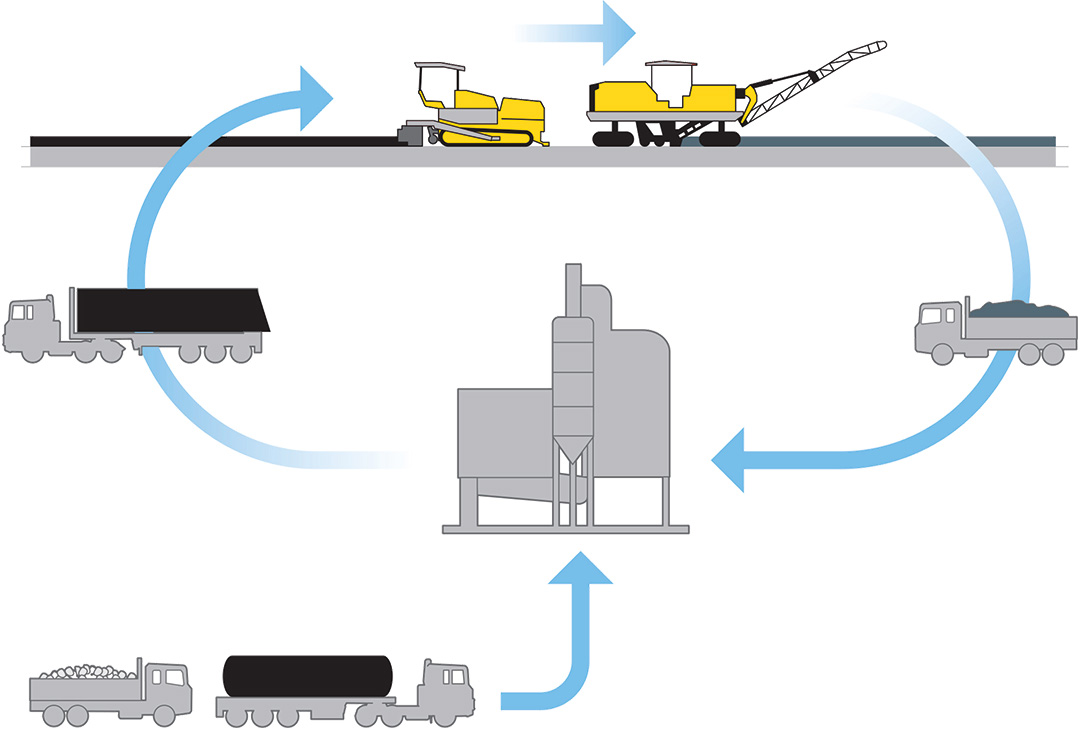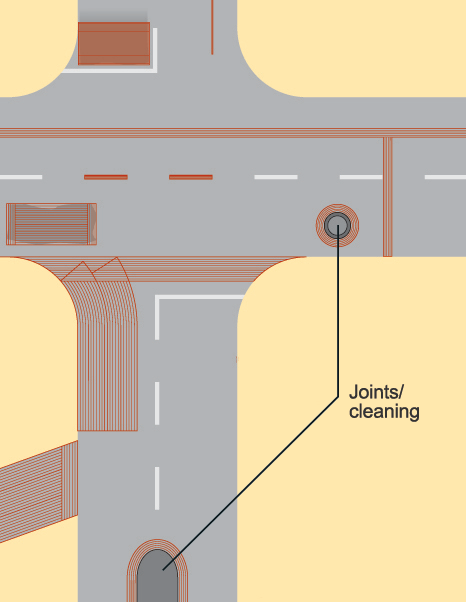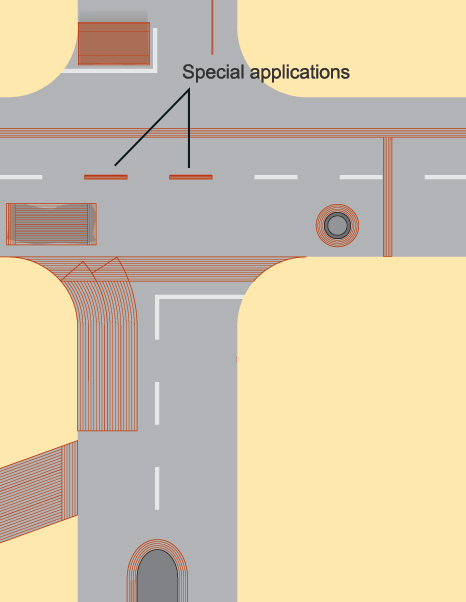Cold milling
A worn out pavement is removed using cold milling equipment, the material is transported to an asphalt plant where it is recycled and forms a part of the new asphalt. This new asphalt is paved and compacted to create a new wearing course.
Cold milling is an integral part of the construction cycle of any road. Asphalt milling is used to remove an old and worn wearing course or the entire asphalt pavement. It can also be used to improve the surface friction on a wearing course that is otherwise in good condition. Joints for a new overlay can be prepared and down-driven manholes can be cut free so that they can be pulled up to the correct level again. A narrow trench for laying down fibre-optic cables, for example, can also be cut. Different machines are used for the different applications depending on capacity requirements, the size of the job site, and manoeuvrability etc. The material that is removed is to a large extent recycled as an unbound gravel base course. It can also be added as part of the virgin asphalt mixes produced in various types of asphalt plants.
Why it is done
Laying a new layer of asphalt on top of an old and damaged one is only a temporary measure. Cracks will migrate through the new material and destroy it in a short time. The adhesion between the layers will also suffer unless the cracked pavement is removed. Curb height is another issue; adding new wearing courses will effectively leave no curb height after a while.
On bridges there is a weight restriction, adding a new wearing course means that 100-150 kg/m2 of asphalt would be added to the existing weight. This could jeopardize the stability of the bridge. The solution to these issues is to use a planer to remove the old asphalt and to replace it with a new layer.
Asphalt paving requires an even surface to provide a uniform layer thickness. Old asphalt wearing courses can be rutted and have an incorrect cross slope. This can all be corrected by using a cold planer to remove the uneven layer.
Compact cold planers are also used to prepare a surface for paving, cutting close to curb stones, around man-holes and gutters etc.
Applications
High capacity/large jobs
The high capacity jobs require large production machines, always equipped with an electronic levelling system. These jobs have a typical working width from 1.0-2.2 meters and a cutting depth of 0-320 mm
The planer is followed by a road sweeper and sometimes high pressure cleaners to ensure a dustfree surface. Tack coating and laying of the new wearing course follows on the cleaned surface. This means that the process must flow continuously and with good results. The method is described as “mill and fill” and is typically used during night-time work on otherwise busy roads. Proper levelling and control of the milling depth, including the logistics on site, are critical on these jobs. 1 cm of the excessive removal of material over 10 km means that an additional 490 tons of asphalt must be paved to reach the correct level. This would represent a significant amount of money.
1. Patch work/city work
These applications are almost as demanding as the high production jobs. Good manoeuvrability, balance and weight are required to finalize the jobs quickly in order to minimize traffic disturbance. These machines are also often operated in confined areas, which means they have to be manoeuvrable and operator friendly. Manhole covers and sewer grates create a challenging working environment for these machines. Good lighting, low noise levels and good all-round visibility are very important considering that a lot of the work is carried out at night. Typical cutting widths range from 350 mm to 1 m and the cutting depth is normally in the range of 5-8 cm, although state-of-the-art planer models can be utilized for deeper cutting work as well.
2. Joints and cleaning
In the preparation of a new overlay on top of an existing wearing course the joints must be prepared, both for the start and at the end of the paved lane. All intersections must also be prepared by milling a “wedge” to create a strong joint. Cleaning up after a high capacity machine includes milling around man-hole covers, sewer grates etc. This is mainly carried out by machines with working widths ranging from 350-500 mm, but a 1000 mm machine with a rear conveyor is also highly manoeuvrable and can almost turn on the spot for effective milling round man-hole covers etc. The most suitable machines for joints, cleaning, and patch and city work are grouped as compact cold planers.
3. Special applications
The removal of the top surface with a fine spaced cutting drum is referred to as fine milling. This includes the removal of shallow ruts in an asphalt or concrete pavement, the correction of a slope for better water drainage, the removal of painted road markings, and frictional improvement of otherwise good wearing courses. Since no material will be placed on the milled surface it is important that this is even and uniform enough for traffic immediately. A regular milling drum with 15 mm bit spacing will not be able to produce the desired surface quality. This application requires changing to a fine milling drum with narrower tooth spacing, typically around half of the regular tool spacing, or less, depending on the job requirements. These jobs are not very demanding from a productivity stand point, however accurate levelling and grade/slope control are required to avoid cutting too deep.





